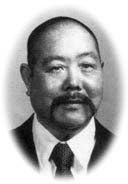
[photo of Wang Shujin practicing Xingyi Quan 'Beng Quan']
The forms of Bagua Zhang and Xingyi Quan look different in practice, but the principles are congruent throughout. When practicing Bagua, use the principles of Xingyi to build power and cultivate qi to the highest level. As Mengzi said, “to cultivate my magnificent qi.” The qi Mengzi was referring to is the true qi that fills the void between heaven and earth. Here are the Eight Secrets of Bagua Zhang:
1. Three Ding (highest, outermost point): The base of the head floats upward; the palms press outward; the tongue ascends. Flatten the back of the head and push the crown upward like a power rushing toward the sky. The head is the master of the body when it is pointing heavenward and allowing the three major acupuncture points on the spine to flow freely. [Yu zhen point, behind the head; lu lu point, between the shoulder blades; wei lu point, near the base of the spine] Then the kidney chi will reach to the ni wan (a point between the eyebrows) to discipline your temperament. Palms press outward with an expression of power like pushing a mountain. Then qi will flow through the body and power will expand to the four limbs. The tongue pressing upward to the roof of the mouth will guide rising kidney qi downwards to the dan tian (near the navel) to solidify your life force.
2. Three Kou (to clamp, compress) Shoulders clamp inward; backs of the hands tops of the feet compress; teeth set. When the back clamps inward the chest will hollow and Qi power will fill your internal organs. When you compress your hands and feet, qi will flow to the arms, and your step will be steady and powerful. When you set the teeth your tendons and bones will compress.
3. Three Yuan (to round, wrap) Round the back and spine; round the chest; round the tiger’s mouth (area between the outstretched thumb and index finger). Round the back and spine and power will fill the body, straighten the coccyx and your spirit will flow upwards. Round the chest inward, and power will fill your elbows; the upper abdomen contracts slightly and your breath flows easily. Round the tiger’s mouth and a great power will flow outward; your hands will have an outwardly stretched and inwardly wrapping strength.
4. Three Min (alert, sensitive, quick): The mind is alert; the eyes sensitive; the hands quick. When your mind is alert you can react quickly to change. When your eyes are sensitive you can anticipate openings. When the hands are agile you can take the initiative before your opponent can enter.
5. Three Bao (embrace, hold): The dan tien embraces; the heart holds; the ribs encompass. The dan tien embraces qi to keep it from scattering, allowing you to attack the enemy. The heart beat holds steady, so you will not panic upon meeting your foe. The ribcage protects the internal organs, so you face the enemy without danger.
6. Three Chuei (hang down, drop): Qi descends, shoulders drop, elbows hang. When qi descends to the dan tien, your body will be as steady as a mountain. Drop the shoulders and the arms will elongate and become more lively, and the shoulders can lead the elbows. Hang the elbows and the forearms will round naturally strengthening the muscles of the chest.
7. Three Qu (to bend, curve): Arms bend; knees bend; wrists bend. When arms curve like a half-moon your strength will be abundant. When knees curve like a half-moon, your power will be substantial. When wrists bend like a half-moon, the power will be concentrated. All this is because of the joints natural stretch and contraction and bouncy unbroken strength.
8. Three Ting (to straighten, pull up): Pull up the neck to straighten the head and qi will flow to the top of the head. Lengthen the spine and flatten the lower back, and power will reach to the tips of the four limbs, and qi will fill your entire body. Pull up the knee caps and your qi will be tranquil and your spirit harmonious, like a tree growing roots.



























1 comment:
I've been following your postings on You Tube since they first appeared and having read the interviews with you in Bagua Journal was thrilled find you are making accessible your extensive knowledge of master Wang Shu Chin's systems. I studied Wang's xing yi with Marnix Wells - a very dedicated, scholarly and excellent person - and have found your training breakdowns to be useful and illuminating. When you publish the book with North Atlantic do you intent to also publish a DVD which collects together the You Tube material and make it available in a higher digital resolution. That would be great – it would certainly be a valuable addition to my own practice.
Post a Comment